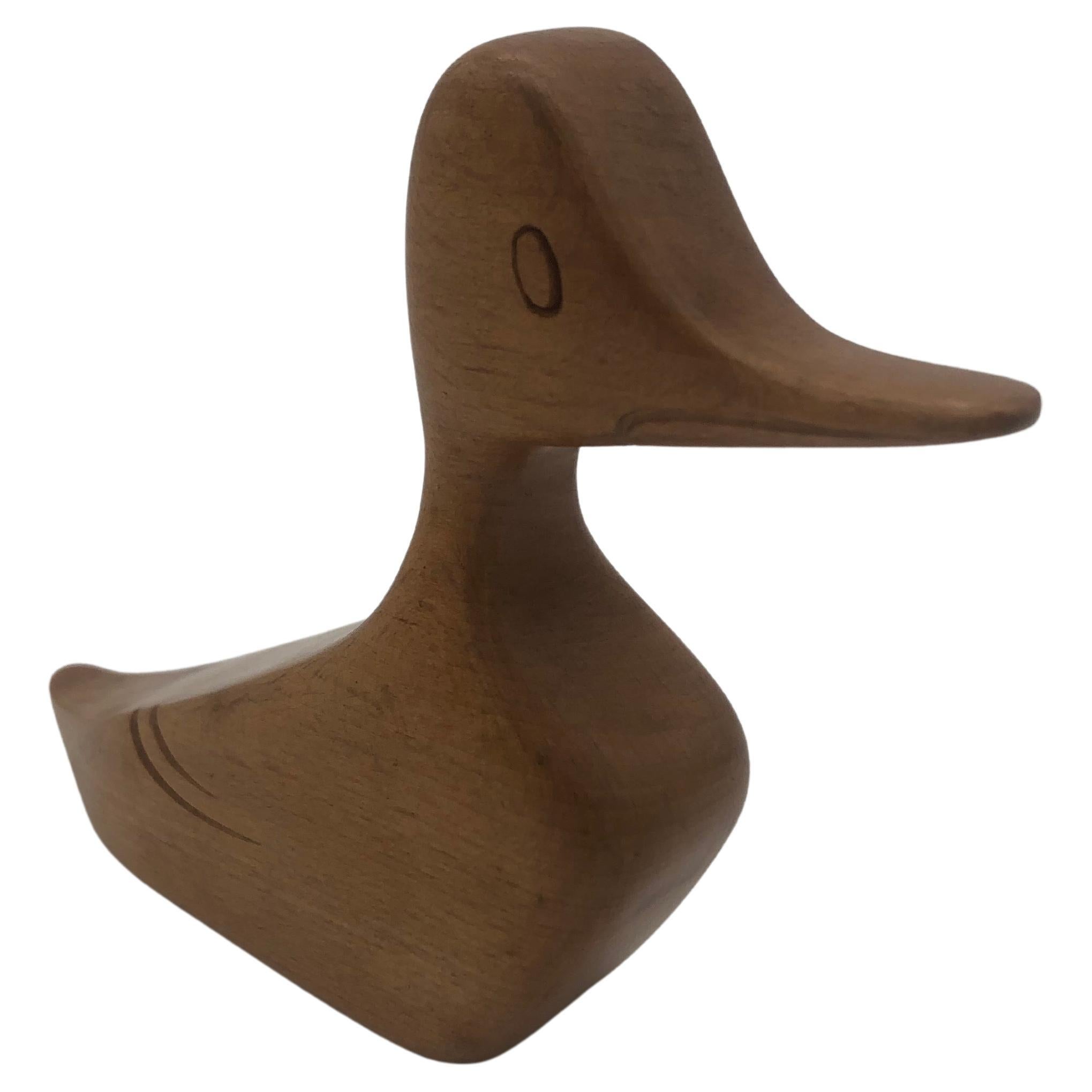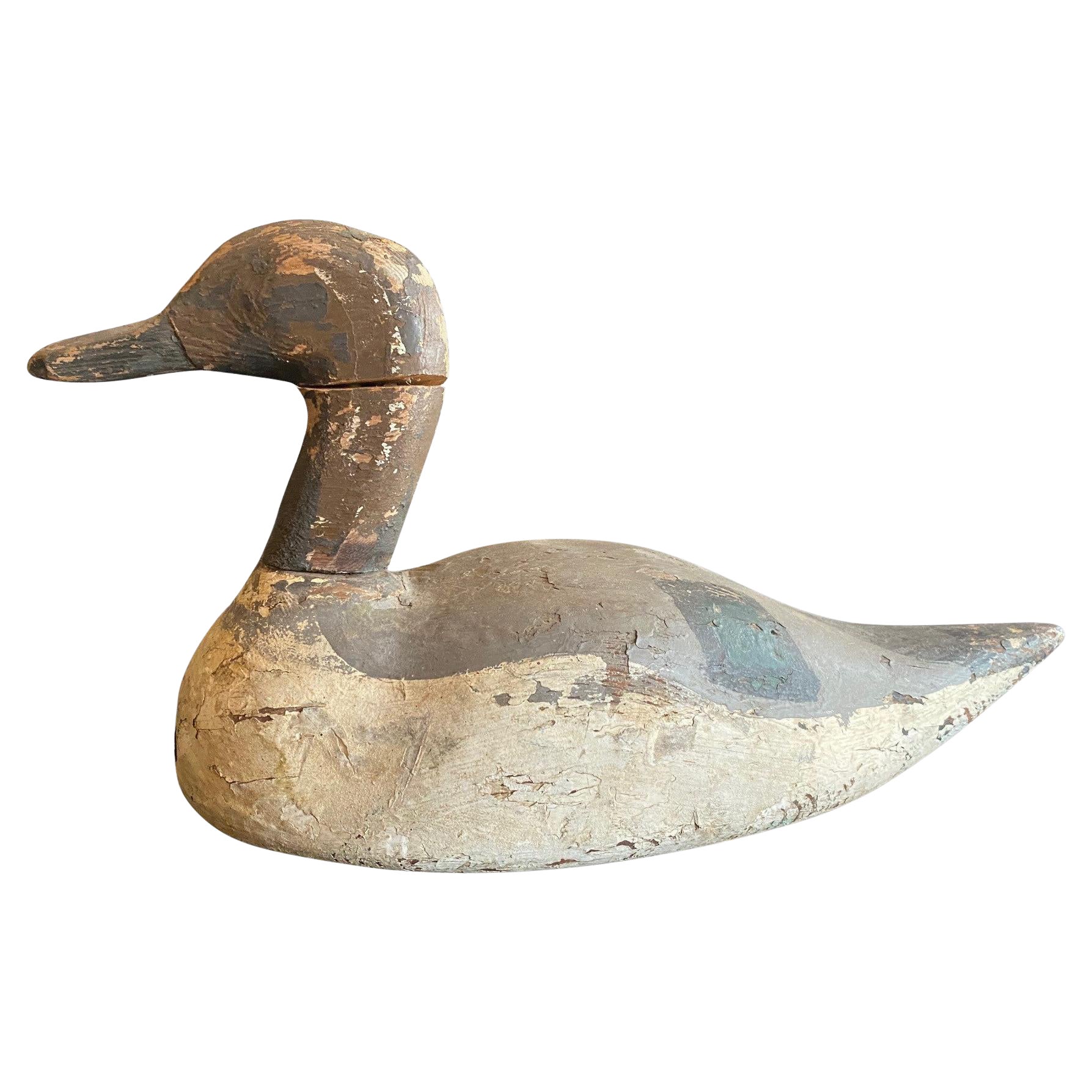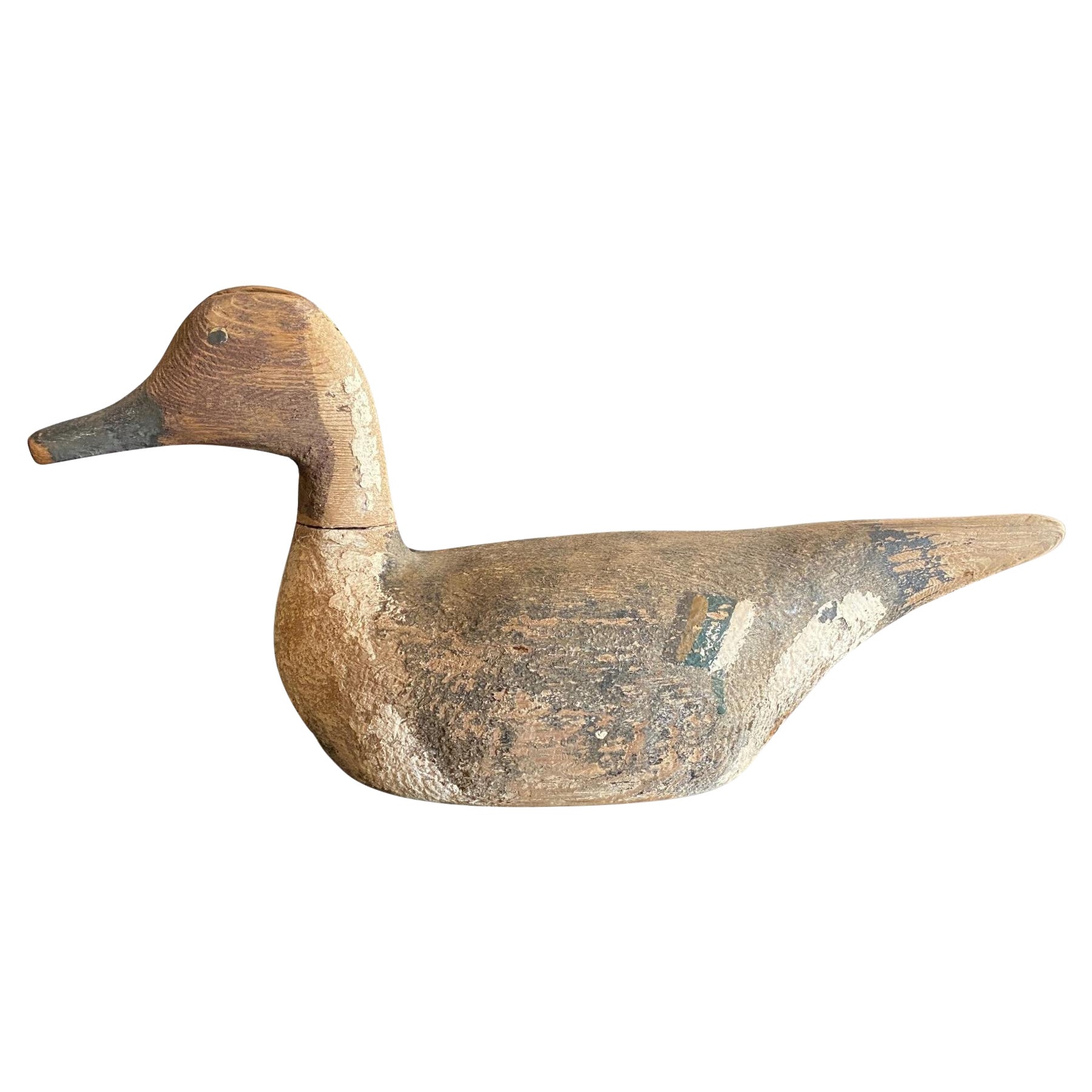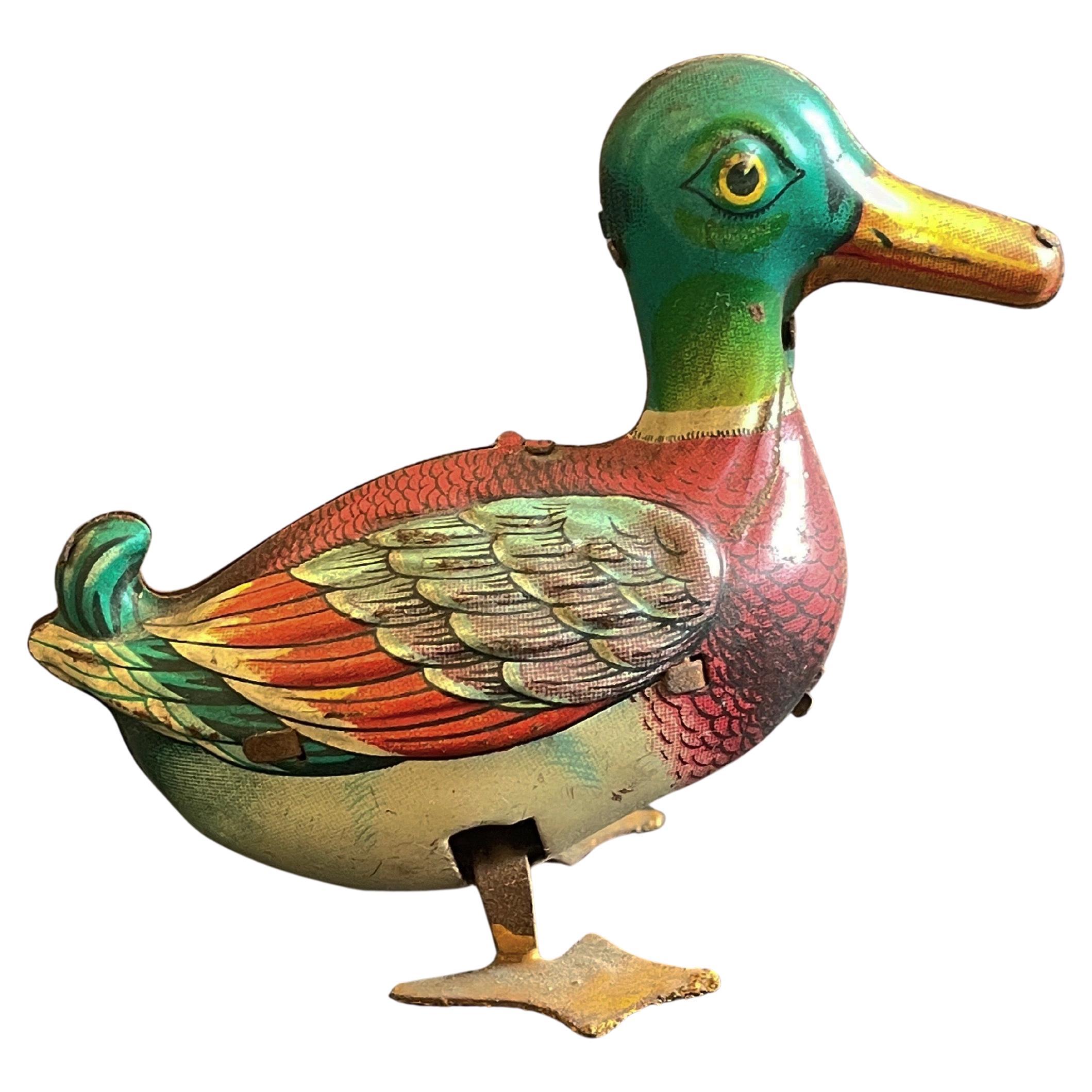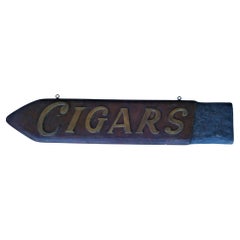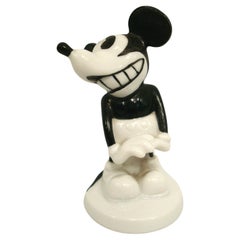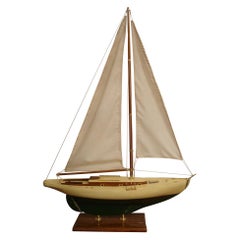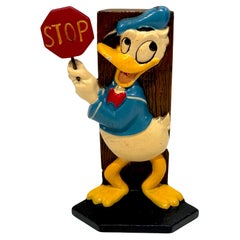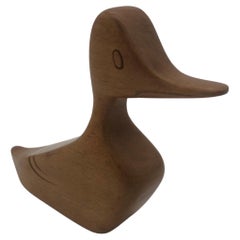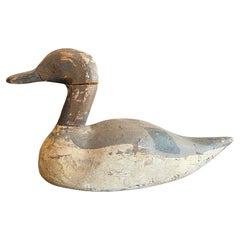Items Similar to 1940´s Donald Duck Hand Carved Wooden Sign
Video Loading
Want more images or videos?
Request additional images or videos from the seller
1 of 14
1940´s Donald Duck Hand Carved Wooden Sign
$5,000
£3,846.33
€4,464.50
CA$7,051.19
A$7,898.52
CHF 4,148.59
MX$96,043.50
NOK 52,534.69
SEK 49,869.55
DKK 33,320.28
About the Item
Fantastic Mid-Century Donald Duck Advertising Sign.
1940´s Hand Carved Advertising Element. Maybe made for a Cinema or for a book presentation.
Over the course of nearly eight decades, Donald Duck has become one of the most celebrated and fondly remembered of all Disney characters. What is sometimes not remembered is that Donald began life in 1934 as a very different duck. His physical appearance, in his earliest films, was one that many of today’s Disney fans would scarcely recognize.
This was not unusual; most of Hollywood’s classic cartoon characters have evolved slowly into their final form. Mickey Mouse, assuming his classic design within his first three films, was the exception to the rule.
Donald’s debut in The Wise Little Hen was built around his voice, supplied by the uniquely talented Clarence Nash. His appearance was simply that of a generic cartoon duck, with the long bill, extended neck, and waddling gait common to his species. As he returned to play additional supporting roles in 1934 and 1935, his appearance remained essentially the same.
In the spring and summer of 1936, in shorts like Orphans’ Picnic and Moving Day, audiences began to see changes in Donald’s design. His bill, still long and ducklike, became more malleable and expressive. His eyes grew larger, telegraphing his changes in expression. No longer a nondescript duck, he was becoming a distinct, unique individual. By this time Donald’s popularity with audiences was unmistakable, and the Disney studio was clearly grooming him for stardom.
Don Donald, the first picture in a Donald Duck starring series, was released in January 1937. By now Donald had settled into the familiar design still remembered today. During these golden years of Disney animation, many artists displayed uniquely specialized talents, and certain of the animators were found to have a special proficiency in animating Donald’s movements and moods. These artists formed a loose talent pool known as the “Duck men.”
Along with the changes in his appearance, and perhaps more important, came the development of Donald’s personality. In his first role in The Wise Little Hen, Donald had existed only to serve the needs of the story. His main characteristics in that film were his laziness, as he dodged the responsibility of helping the hen plant and harvest her corn, and a mischievous glee when he fooled her into thinking he was too sick to work.
It was in his second appearance, in Orphans’ Benefit (1934), that Donald showed his true colors. In this short he attempted a stage performance for an audience of unruly youngsters, who heckled him mercilessly and threw objects at him. Donald lost his temper and exploded in a tantrum, and animator Dick Lundy devised a distinctive action to show off his fighting rage: hopping on one foot, brandishing his fist, challenging all comers.
It was a career-making scene. Donald Duck was a naturally funny character anyway, but when he became angry, he was hilarious. In subsequent films he retained his lazy and mischievous attributes, but his temper became his defining trait. Mickey Mouse, increasingly a nice guy in the mid-1930s, made a direct appeal to the audience’s sympathies, but Donald, of the thunderous rages, was clearly built for comedy.
The story department obliged, unleashing a host of slapstick indignities on him. In the first three years of his screen life, Donald was chased by a runaway saw blade in The Dognapper, swept over a waterfall and brained with a tree branch in On Ice, trampled by stampeding horses in Mickey’s Polo Team, dive-bombed by a swarm of bees in Orphans’ Picnic, inflated like a balloon and sent careening through the air in Moving Day, fired from a cannon and electrocuted in Mickey’s Circus, and smashed through a window and dangled from a precarious height in Donald and Pluto. He took it all, and belligerently bounced back for more.
By the late 1930s, both Donald’s design and his personality had crystallized. The years 1937-1941 might be considered the peak of his acting career; they produced a series of delightful shorts which drove him, with exquisite artistry, to the breaking point time and again. When a 1938 audience saw a Donald Duck short with the title Self Control—and saw Donald, in its opening scene, happily relaxing in his hammock—they knew what to expect. The fun was in watching how his eponymous self-control would be shattered by film’s end; by what carefully crafted degrees the filmmakers would inflict life’s torments on him until, step by step, he lost his temper completely. And Donald never disappointed; his films invariably ended with a wild, sputtering paroxysm of rage.
We have specialized in the sale of Art Deco and Art Nouveau and Vintage styles since 1995. If you have any questions we are at your disposal. Pushing the button that reads 'View All From Seller'. And you can see more objects to the style for sale. Why are there so many antiques in Argentina?
In the 1880 – 1940 there was a grate wave of immigration encouraged by the periods of war that were taking place. 1st World War took place between 1914 and 1918 2nd World War took place between 1939 and 1945 The immigrants options were New York or Buenos Aires. Tickets were cheap and in Buenos Aires they were welcomed with open arms, as it was a country where everything was still to be done. Argentina was the country of new opportunities, labour was needed and religious freedom was assured, in many cases the of the family travel first until they were settled and then the rest of the family members join them. In the immigrant museum “Ellis Island Immigrant Building” in New York you can se the promotional posters of the boats that would take them to a new life. Between the years 1895 and 1896, Argentina had the highest DGP (gross domestic product) per capita in the world according to the Maddison Historical Statistics index, this situation arose due to the large amount of food being exported to European countries, which were at war. The Argentinean ships left the port of Buenos Aires with food, but they returned with furniture, clothes and construction elements, (it´s common to see this the old buildings of the historic neighbourhood of San Telmo, the beams with the inscription “Made in England)”, as well as many markets that were built in Buenos Aires, such us the San Telmo Market, whose structure was brought by ship and afterwards assembled in 900 Defensa Street. With the great influence of European immigrants living in the country, the children of the upper classes travelled to study in France, resulting in the inauguration of “La Maison Argentinienne”, on 27th of June 1928, in the international city of Paris, which hosted many Argentinians that were studying in Frace. It´s the fourth house to be built after France, Canada and Belgium, being the first Spanish-speaking one. Still in place today (17 Bd Jourdan, 75014, Paris, France). Many of the children of these wealthy families who attended international art exhibitions, museums and art courses abroad, took a keen interest in the European style. This is why Buenos Aires was at the time referred as “The Paris of South America”. Between the years 1890 and 1920 more than a hundred Palaces were built on Alvear Avenue the most exclusive avenue in Buenos Aires. Today some of these palaces have been transformed into museums, hotels and embassies. In the year 1936, the Kavanagh building was inaugurated, it was the tallest reinforced concrete building in South America. During 1994 the American Society of Civil Engineers distinguished it as an “international engineering milestone”, and it´s now considered a World Heritage of Modern Architecture. At the time was common to hire foreign architects such as Le Corbusier, who visited Buenos Aires/Argentina in 1929 and in 1948 he drew up the blueprints for a house built in La Plata City (which was declared a World Heritage Site). In 1947, the Hungarian architect Marcelo Breuer designed “Parador Ariston” in the seaside city of Mar del Plata. After an Argentinean student at Harvard University convinced him to come to Argentina. He worked on an urban development project in the Casa Amarilla, area of La Boca. The Ukrainian architect, Vladimiro Acosta, arrives in Argentina in 1928 and worked as an architect until que moved to Brazil. Antonio Bonet, a Spanish architect who worked with Le Corbusier in Paris, arrives in Argentina in 1937, where he carried out several architectural works and in 1938 designs the well-known BFK chair. Andres Kálnay, of Hungarian origin, made around 120 architectural masterpieces, among which the former Munich brewery stands out, he even made the furniture’s design. The German architect, Walter Gropius, director of the Bauhaus, lived in Argentina, where he wrote articles for “Sur” magazine and founded in Buenos Aires, an architectural firm with Franz Möller, who was also an architect, where he built two houses. At the same time several famous designers decided to immigrate to Argentina, among them we can find the well-known French designer, Jean-Michel Frank, who arrived in the country in 1940 and also worked for the Rockefeller family. Special pieces were made, which were sold exclusively in the country, such as the well-known German company “WMF”, who sold their products by catalogue, which were chosen by the ladies of high society in the list of wedding gifts, as well as the pieces designed by Christofle. The Swiss sculptor Alberto Giacometti, made special pieces for Argentinean mansions. In 1904 the first Jansen branch outside Paris was established in Buenos Aires, as the Argentinean clientele demanded a large amount of furniture, from the end of the 19th century to the mid-20th century. In 1970, the brand Rigolleau Argentina made pieces authorised by Lalique. The brands Maple and Thompson also set up shop in the country. The French plastic artist, Marcel Duchamp moved to Argentina in 1918-1919. Glass signed Gallé, Charder, Leverre, Schneider, Muller and other French firms. They were bought in flower shops and were given to ladies with beautiful floral arrangements. Some furniture manufacturers travelled to international fairs and bough the patterns to produce the furniture in Argentina, such as the furniture firm Englander and Bonta, who bought the patterns in Italy. It is worth mentioning that in Argentina we have the largest community of Italians outside of Italy, as it is estimated that 70 percent of the inhabitants have at least one Italian descendant, followed by Spanish immigrants. The most Important furniture stores in Argentina: Comte is founded in 1934 (under the direct management of Jean Michel Frank in 1940). Nordiska (Swedish company established in 1934). Churba in 1960, a company that brought foreign designers to present their furniture in the country: Denmark: (Arne Jacobsen, Finn Juhl, Bender Madsen, Ejner Larsen, Poul Kjaerholm, Hans Wegner) Sweden: (Hans Agne Jakobsson, Gustavsberg) United States: (Herman Miller) Finland: (Lisa Johansson, Folke Arstrom, Tapio Wirkkala, Alvar Aalto, Timo Sarpaneva) Swedish Factory: (Orrefors) Italy: (Littala, Vico Magistretti, Emma Gismondi, Gae Aulenti, Angelo Mangiarotti, Elio Martinelli, Gianna Celada, Angelo Mangiarotti, Mario Bellini, Carlo Scarpa) Finland: (Olivia Toikka) Plata Lappas (Lappas Silver): a goldsmith shop founded in 1887 in Argentina by Alcibiades Lappas of Greek origin. In 2019, in Argentina took place “the Art Deco world congress” . Argentina currently has more than 100 Art Deco buildings and another 90 Art Nouveau buildings throughout the city of Buenos Aires. Argentina is a country that has not been involved in many wars, which is why it has been a refuge for works of art and antiques from different periods of time, unlike European countries. That is way many collectors, museums and antique dealers from all over the world visit it, you should not miss the opportunity to visit this great country.
- Attributed to:Walt Disney Productions (Author)
- Dimensions:Height: 31.89 in (81 cm)Width: 19.69 in (50 cm)Depth: 0.79 in (2 cm)
- Style:Mid-Century Modern (Of the Period)
- Materials and Techniques:
- Place of Origin:
- Period:
- Date of Manufacture:1940s
- Condition:Wear consistent with age and use. Minor losses.
- Seller Location:Buenos Aires, AR
- Reference Number:1stDibs: LU2027345699232
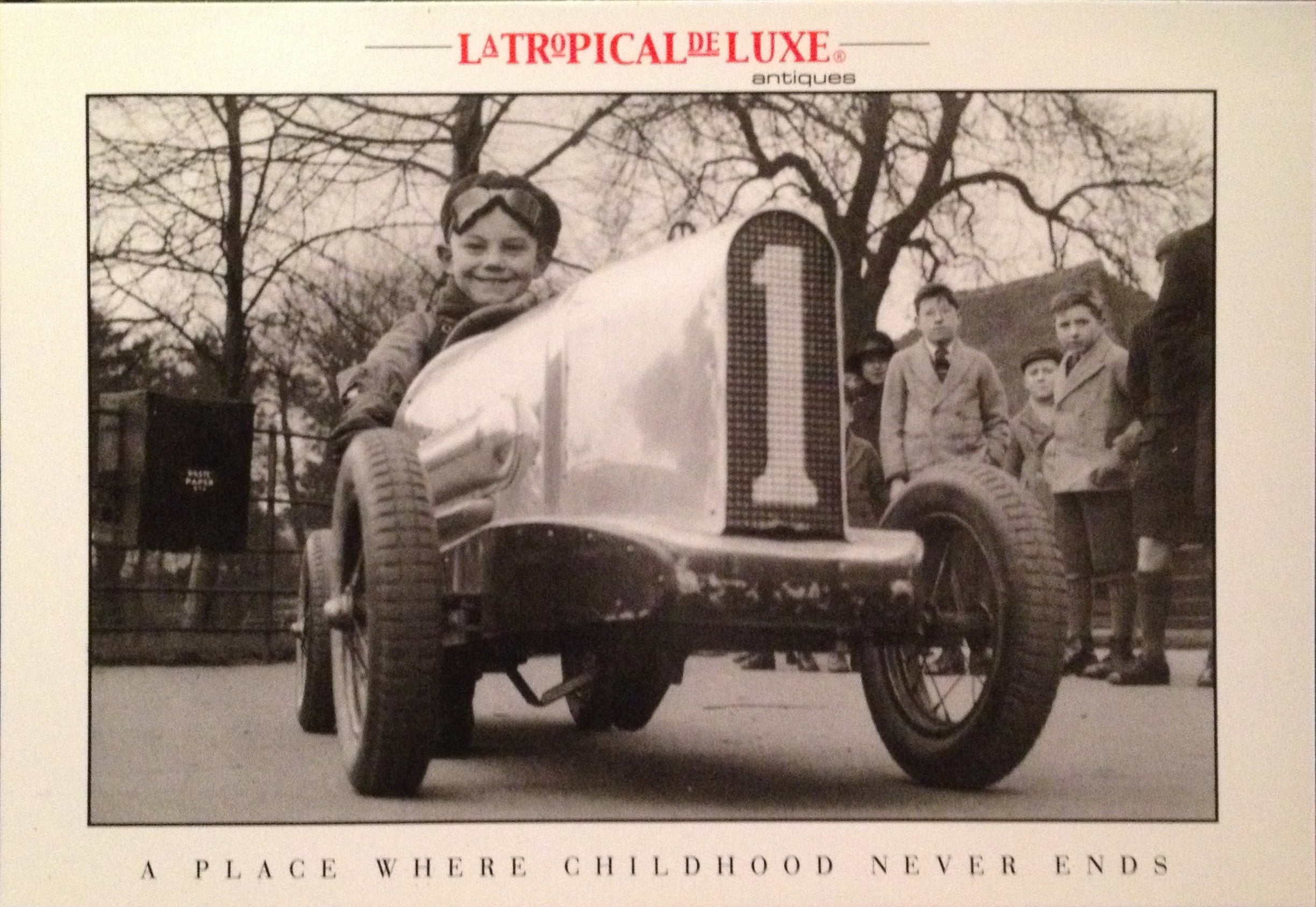
About the Seller
4.9
Vetted Professional Seller
Every seller passes strict standards for authenticity and reliability
Established in 2002
1stDibs seller since 2016
320 sales on 1stDibs
Typical response time: 1 hour
- ShippingRetrieving quote...Shipping from: Buenos Aires, Argentina
- Return Policy
Authenticity Guarantee
In the unlikely event there’s an issue with an item’s authenticity, contact us within 1 year for a full refund. DetailsMoney-Back Guarantee
If your item is not as described, is damaged in transit, or does not arrive, contact us within 7 days for a full refund. Details24-Hour Cancellation
You have a 24-hour grace period in which to reconsider your purchase, with no questions asked.Vetted Professional Sellers
Our world-class sellers must adhere to strict standards for service and quality, maintaining the integrity of our listings.Price-Match Guarantee
If you find that a seller listed the same item for a lower price elsewhere, we’ll match it.Trusted Global Delivery
Our best-in-class carrier network provides specialized shipping options worldwide, including custom delivery.More From This Seller
View AllHen Merganser Hunting Decoy attributed to John Dawson Folk Art, Americana
By John Dawson
Located in Buenos Aires, Olivos
Carved and polychromed wood; retains original painted surface. Glass Eyes.
Attributed to John Dawson, Trenton, New Jersey, 1900-1925.
Dawson worked as a ki...
Category
Early 20th Century American Art Nouveau Decoys
Materials
Wood
$9,600 Sale Price
61% Off
Free Shipping
Cigars Store / Trade Folk Art Wooden Carved Sign. c 1900
Located in Buenos Aires, Olivos
American Folk art wooden "CIGARS" sign from the 1920's.
Great old Store Trade sign. Wood cut to cigar shape. Lettered in Gold Paint.
In good conditions, it was a in doors sign. Perfect for any cigar smoker.
Cigars History:
A cigar is basically dried tobacco leaves that are rolled and wrapped by other tobacco leaves in order to give you a full tobacco smoking experience.
Cigars are becoming more popular all around the world recently because they are exposed to a pop culture where a lot of famous people like Michael Jordan and Arnold Schwarzenegger smoke them.
In order to understand why cigars have become very well-known, we need to take a good look at their history and where they came from. That way, we can truly understand this pop phenomenon. Here is a brief history of cigars.
Origin of Cigars
The exact origin of cigars is not entirely known but historians believe that cigars were first invented by the ancient Mayans.
The ancient Mayans would collect tobacco leaves and wrap them up in a plantain leave in order to smoke it. An ancient Mayan pot...
Category
Early 20th Century American Folk Art Signs
Materials
Wood
Rare Disney Mickey Mouse Porcelain Figurine, Rosenthal 1930´s
By Walt Disney, Rosenthal
Located in Buenos Aires, Olivos
Extremely Rare Antique / Vintage Disney Mickey Mouse beautiful porcelain figurine by the famous Rosenthal Germany , circa 1930s This is #551 in the series w/incised number under base...
Category
Vintage 1930s German Mid-Century Modern Toys and Dolls
Materials
Porcelain
Sailboat Model, Painted Wooden Body, 1930s
Located in Buenos Aires, Olivos
Sailboat model on stand. Painted wood body and bronze accessories.
Made between 1920s-1930s. Very nice restored conditions.
Very decorative item, perfec...
Category
20th Century Unknown Art Deco Nautical Objects
Materials
Bronze
Jack Daniels Old Number 7 Whiskey Tin Advertising Bar Sign / 1950s Midcentury
By Jack Daniels
Located in Buenos Aires, Olivos
Jack Daniels old number 7 whiskey tin advertising bar sign / 1950s midcentury.
Perfect to decorate a Man Cave Bar.
We have specialized in the sale of Art...
Category
Mid-20th Century American Mid-Century Modern Barware
Materials
Tin
Art Deco Pan-Am DC3 Wooden Airplane Desk Model, Midcentury
By Pan American Airways
Located in Buenos Aires, Olivos
Art Deco / midcentury large DC3 desk aviation model.
Pan-Am wooden airplane model.
It was in an office of the company in South America.
Very good restored conditions. Slight age wear.
History
Pan American Airways began the first transatlantic passenger service on this day in 1939. Pan American World Airways, as it was to be known, commonly known as Pan Am, was the principal United States international air carrier from the late 1920s until its collapse on December 4, 1991. Founded in 1927 as a scheduled air mail and passenger service operating between Key West, Florida, and Havana, Cuba, the airline became a major company credited with many innovations that shaped the international airline industry, including the widespread use of jet aircraft, jumbo jets, and computerized reservation systems.
The history of Pan American Airways is inextricably linked to the expansive vision and singular effort of one man – Juan Trippe. An avid flying enthusiast and pilot, Trippe, only 28 years old when he founded the airline, lined up wealthy investors and powerful government officials from his personal acquaintances in the high-society of the 1920s. However, Pan Am’s first flight was an inauspicious start to its epic saga.
In 1927, facing a Post Office deadline for the commencement of mail carriage, Pan Am had no working equipment for its sole airmail contract between Key West and Havana. Fortunately for Pan Am, a pilot with his Fairchild seaplane arrived at Key West and was willing to carry the mail to Cuba for the start up operation. It is fitting that Pan Am’s first flight would be over water, since the airline would Pioneer overseas routes throughout its history.
Pan Am’s fortunes took a turn for the better in the fall of 1927. Through the heavy lobbying efforts of Juan Trippe, Pan Am was selected by the United States government to be its “chosen instrument” for overseas operations. Pan Am would enjoy a near monopoly on international routes. Added to Pan Am’s Cuba route were lines serving Mexico, Central America, the Dominican Republic, Haiti and Puerto Rico. Most of these destinations were port cities, which could be reached only by landing on water. Therefore Pan Am made good use of its “flying boats,” the Sikorsky S-38 and S-40. Flights were eventually expanded to serve much of South America as well.
EnlargePan Am’s fleet of Clippers allowed the airline to conquer the Pacific in the mid-1930s. The flying boats would later be put to military use in WWII.
Just a few years later, Pan Am launched its effort to cross the world’s largest oceans. Survey flights across the Pacific were conducted with the Sikorsky S-42 in 1935, but passenger service required bigger and better aircraft. Accompanied by much fanfare, the Martin M-130 was introduced in 1936, followed by the Boeing 314...
Category
Mid-20th Century Unknown Mid-Century Modern Aviation Objects
Materials
Wood
You May Also Like
Donald Duck Cast Iron Stop/Enter Doorstop by Walt Disney Productions, 1971
By Walt Disney Productions
Located in West Palm Beach, FL
Donald Duck Cast Iron Stop/Enter Doorstop by Walt Disney Productions, 1971
Signed by Walt Disney Productions, 1971
A rare and authentic 1971 Walt Disney Productions Donald Duck Cast Iron Stop/Enter Doorstop is a collector's gem. Measuring inches high, 5 inches wide, and 3 inches deep, this unique piece features Donald Duck in his classic sailor shirt, cap, and bow tie, holding a movable and removable 2-inch diameter green "Enter" and red "Stop" sign. Due to patent infringements, only a limited number of these doorstops were produced, as Disney had not granted permission for their creation, making original pieces like this highly sought-after. Unlike the numerous "knock-offs" on the market, this doorstop is guaranteed to be original, complete with its authentic sign. It remains in near-mint condition, with the paint still brightly colored, showcasing the high-quality craftsmanship and attention to detail typical of Disney products. This doorstop not only serves a practical function but also stands as a delightful piece of Disney memorabilia...
Category
20th Century American Animal Sculptures
Materials
Iron
$1,000 Sale Price
20% Off
Wooden Duck by Franz Hagenauer, Vienna, Austria
By Franz Hagenauer
Located in Vienna, AT
Wonderful hand-carved wooden duck.
Small carved details for the eyes, spout and wings.
Beautiful wood grain.
The spots on the back and the belly loo...
Category
Vintage 1950s Austrian Art Deco Animal Sculptures
Materials
Wood, Beech
Hand Carved Large Vintage Antique Wood Duck Decoy Sculpture, Early 20th Century
Located in Studio City, CA
A fantastic early to Mid-20th Century hand-carved and painted wood duck or mallard decoy. This piece has an wonderful color and texture.
From an impressive Los Angeles vintage duck and antique swan decoy...
Category
Early 20th Century American Folk Art Decoys
Materials
Wood, Paint
Mickey Mouse Vintage Wood Sculpture
Located in Palm Beach, FL
Whimsical Mickey Mouse wood sculpture hand carved and painted in his blue tuxedo.
Category
Mid-20th Century American Mid-Century Modern Figurative Sculptures
Materials
Hardwood
Hand Carved Large Vintage Antique Wood Duck Decoy Sculpture, Early 20th Century
Located in Studio City, CA
A fantastic early to Mid-20th Century hand-carved and painted wood duck or mallard decoy. This piece has an wonderful color and texture.
From an impressive Los Angeles vintage duck and antique swan decoy...
Category
Early 20th Century American Folk Art Decoys
Materials
Wood, Paint
Vintage Litho Wind-up Tin Toy Duck 1940's to 1950's, West Germany, US Zone
By Deutsches Reichs Gebrauchs Muster (D.R.G.M.) 1
Located in Andernach, DE
West-German tin mechanical tin toy from the 1940s to 1950's in the shape of a duck, which features waddling legs, once the
'beast' ist put in motion via it's legs.... but be aware: ...
Category
Mid-20th Century Japanese Mid-Century Modern Toys and Dolls
Materials
Sheet Metal

